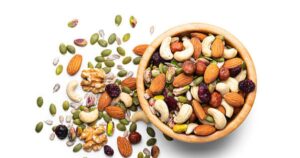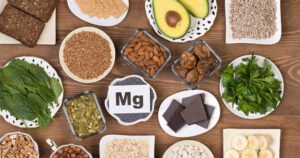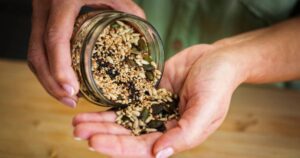15 Nuts and Seeds High in Magnesium for Better Health

Magnesium is one of the essential minerals that plays a key role in hundreds of bodily processes including muscle and nerve function, energy production and heart health. Yet many people don’t get enough through their diet. By focusing on nuts and seeds high in magnesium, you can tap into reliable natural sources of this vital nutrient. In this guide you’ll discover the best options, understand why magnesium matters and get practical tips to include these magnesium-rich foods in your daily routine.Why Magnesium Matters
Magnesium supports more than 300 enzyme-driven reactions in the body—such as converting food into energy, synthesising protein, repairing DNA and regulating muscle and nerve function.
According to the U.S. National Institutes of Health (NIH), good sources of magnesium include legumes, whole grains, green leafy vegetables – and notably nuts and seeds.
Inadequate magnesium intake has been linked with higher risk of high blood pressure, type 2 diabetes, poor sleep and muscle/joint issues.
How Much Magnesium Do You Need?
For most adults, the Recommended Dietary Allowance (RDA) is around 310-420 mg per day depending on age and gender. Ensuring you include multiple magnesium-rich foods helps meet this target without relying on supplements.
Top 15 Nuts & Seeds High in Magnesium
Here are 15 excellent sources of magnesium in the nut and seed family, listed with their benefits and simple serving ideas.

- Pumpkin (pepita) seeds – One of the richest: roughly 150 mg of magnesium per ounce. Great roasted as a snack or sprinkled on yogurt or salads.
- Hemp seeds – High in magnesium, plus complete protein and healthy fats. Add to smoothies, salads or porridge.
- Chia seeds – Around 100-110 mg per ounce, with fibre and omega-3s. Make chia pudding or stir into oatmeal.
- Almonds – Roughly 80 mg per ounce; a convenient nut for snacking. Helps you ingest magnesium via nuts and seeds easily.
- Cashews – About 70-80 mg per ounce; also rich in healthy fats and minerals. Good as a raw snack or in nut-mixes.
- Brazil nuts – While known for selenium, they also provide a solid amount of magnesium. Enjoy 1-2 nuts as a high-nutrient snack.
- Flaxseeds – Whole or ground flaxseeds deliver magnesium and fibre; ideal for sprinkling over cereal or baking into muffins.
- Sesame seeds – These little seeds contribute to your mineral intake; great in dressings, bread, or sprinkled over vegetables.
- Pistachios – On the lighter side compared to some seeds, but still a useful source of magnesium. Handy for on-the-go snacking.
- Walnuts – Though best known for omega-3, walnuts also supply magnesium and are easy to blend into salads or desserts.
- Pecans – Another nut that helps diversify your “best sources of magnesium” list; good choice for variety and flavour.
- Sunflower seeds – Affordable seed option: good for snacking, baking, or topping dishes; contributes to your daily magnesium target.
- Pumpkin seed butter – If you dislike seeds plain, seed butters are a tasty alternative and still deliver magnesium in a spreadable form.
- Nut/seed mix with added seeds – Combining almonds, cashews, pumpkin seeds and chia seeds in one snack gives a powerful mix of magnesium-rich foods.
- Mixed whole-grain snack bars with seeds & nuts – For convenience, look for bars that include a variety of nuts & seeds high in magnesium; useful for busy lifestyles.
How to Include These Magnesium-Rich Foods in Your Daily Life
Integrating foods high in magnesium for energy and overall wellness doesn’t require major diet overhaul. Here are practical tips:

- Start your day with oatmeal topped with chia + flaxseeds and almonds.
- Sip a smoothie with hemp seeds and flaxseeds for a mid-morning boost.
- Keep a small bag of mixed nuts & seeds in your car or desk for quick snacking.
- Use seed butters or nut butters (almond, pumpkin seed butter) on whole-grain toast.
- Sprinkle sunflower/sesame seeds on salads or cooked vegetables at dinner.
- Choose snack bars that specifically list seeds and nuts high in magnesium (rather than sugar-heavy bars).
Why Choosing Nuts and Seeds Over Supplements Can Be Better
While magnesium supplements exist, research suggests getting minerals from whole foods often brings additional benefits because real foods contain fibre, healthy fats, antioxidants and other nutrients working together. Foods such as nuts and seeds deliver this “whole package” approach. Moreover, the absorption from whole-food sources is generally safe and well tolerated.
Potential Challenges & What to Watch Out For
Here are some considerations when focusing on the best sources of magnesium via nuts and seeds:
- Portion size matters: Nuts and seeds are calorie-dense. A one-ounce (28 g) serving is a reasonable target.
- Allergies: If you have tree-nut or seed allergies, ensure you choose safe options or avoid entirely.
- Phytates in seeds: Some seeds contain phytates which can reduce mineral absorption. But having a variety of foods helps mitigate this issue. 6
- Salt/sugar coated snacks: Avoid versions of nuts/seeds loaded with added sugar or salt, as that reduces their health benefit.
A Simple Story: How I Boosted My Magnesium Without Pills
Last year, I found myself constantly fatigued despite getting 8 hours of sleep. A dietitian suggested I check my magnesium intake and realised I was eating very little of the magnesium-rich foods like nuts and seeds. I started adding a tablespoon of pumpkin seeds and a handful of almonds each morning and snacked on a mix of cashews + chia seeds in the afternoon. Within three weeks, my energy improved, I felt less “wired” at night and my focus during afternoon work improved. This small change in incorporating nuts and seeds high in magnesium made a real difference for me without needing any supplement.
Key Health Benefits of Magnesium-Rich Nuts and Seeds
Including nuts and seeds high in magnesium in your daily diet offers a wide range of proven health benefits. These magnesium-rich foods not only fuel your energy levels but also support overall body balance and long-term wellness.
- Boosts Natural Energy: Magnesium helps your body create and use energy efficiently. Consuming foods high in magnesium for energy like almonds, cashews, and pumpkin seeds can reduce tiredness and improve endurance.
- Supports Heart and Muscle Health: Regular intake of magnesium-rich foods keeps your heartbeat steady, supports muscle recovery, and lowers the risk of high blood pressure or cramps.
- Improves Bone Strength: Magnesium works with calcium and vitamin D to keep bones dense and strong, making nuts and seeds some of the best sources of magnesium for long-term skeletal health.
- Enhances Sleep and Relaxation: Magnesium naturally relaxes the nervous system, helping you unwind and sleep better. A handful of magnesium-rich nuts like almonds before bed can improve sleep quality.
- Balances Blood Sugar Levels: Adding magnesium-rich nuts and seeds to your meals helps regulate insulin and glucose, reducing the risk of type 2 diabetes.
- Reduces Stress and Anxiety: Adequate magnesium levels are linked to improved mood and lower stress. These best sources of magnesium can help calm your mind naturally.
- Supports Brain and Memory Function: Magnesium improves communication between brain cells, enhancing focus, learning, and memory retention.
Overall, these nuts and seeds high in magnesium play a vital role in maintaining energy, heart health, sleep, and mood balance—making them an easy yet powerful addition to your daily nutrition.
Pro Tips for Getting the Most Magnesium Naturally
Adding nuts and seeds high in magnesium to your diet is simple, but using them the right way can help you absorb more nutrients and get the best health results. Follow these expert-backed tips to make the most of every serving.
- 1. Soak or Roast for Better Absorption: Lightly soaking or dry-roasting magnesium-rich foods like almonds or pumpkin seeds can improve mineral absorption and make them easier to digest.
- 2. Combine with Vitamin D and Calcium Foods: Pair nuts and seeds high in magnesium with foods containing calcium and vitamin D (like yogurt or leafy greens) for enhanced bone and muscle support.
- 3. Choose Unsalted and Raw Varieties: Processed or salted versions may add unnecessary sodium. Opt for raw or dry-roasted forms to keep your snacks clean and heart-friendly.
- 4. Add to Smoothies or Salads Daily: Sprinkle chia, flax, or sunflower seeds into smoothies, oatmeal, or salads for an easy way to boost magnesium-rich foods in your daily meals.
- 5. Keep Portion Control in Mind: Even the best sources of magnesium are calorie-dense. One to two handfuls a day is enough for most adults to meet their magnesium needs without excess calories.
- 6. Stay Hydrated: Magnesium works closely with electrolytes like potassium and sodium. Drink enough water throughout the day to help your body use these minerals efficiently.
- 7. Rotate Different Nuts and Seeds: Instead of eating just one type, mix almonds, cashews, pumpkin, and sunflower seeds to get a balanced range of nutrients and healthy fats.
These simple pro tips for magnesium-rich foods can help you naturally improve energy, sleep, and heart health — without relying on supplements. Small daily habits make a big difference over time.
Conclusion
Choosing the right nuts and seeds high in magnesium is a simple yet powerful way to support your health—boost energy, support your heart, improve sleep and cover a key mineral that many people lack. By including just a handful of these magnesium-rich foods each day, you’re not only ticking off numbers, but nourishing your body in a smart, natural way. Make them part of your snack routine, your breakfast or your dinner topping and let your body thank you.
Disclaimer: This article is for informational purposes only and does not constitute medical advice. If you have existing health conditions or are pregnant, please consult a qualified healthcare professional before making significant changes to your diet or supplement routine.
For further reading on magnesium, see the fact sheet by the National Institutes of Health Office of Dietary Supplements and the mineral nutrition overview by the Harvard T.H. Chan School of Public Health. NIH Magnesium Fact Sheet and Harvard Nutrition Source: Magnesium.
Frequently Asked Questions (FAQ)
1. Why is magnesium important for the body?
Magnesium supports over 300 body functions, including energy production, nerve control, and muscle strength. It also helps regulate blood pressure and improve bone health, making magnesium-rich foods essential for daily nutrition.
2. Which nuts and seeds are highest in magnesium?
Some of the top nuts and seeds high in magnesium include almonds, cashews, pumpkin seeds, chia seeds, sunflower seeds, and flaxseeds. These are among the best sources of magnesium for overall health and energy.
3. How much magnesium should adults get daily?
According to the National Institutes of Health (NIH), adult men should get around 400–420 mg of magnesium daily, while adult women need about 310–320 mg.
4. Can magnesium-rich nuts and seeds help with sleep?
Yes, magnesium promotes relaxation by calming the nervous system. Eating a handful of magnesium-rich nuts like almonds or walnuts before bedtime can help improve sleep quality naturally.
5. Are there any side effects of eating too much magnesium?
From natural foods, magnesium rarely causes side effects. However, excessive intake from supplements may lead to nausea or diarrhea. It’s best to get magnesium from foods high in magnesium for energy rather than pills.
6. Do magnesium-rich foods support heart health?
Absolutely. Magnesium helps control blood pressure and supports normal heart rhythm. Regular intake of nuts and seeds high in magnesium can reduce the risk of heart disease and improve circulation.


